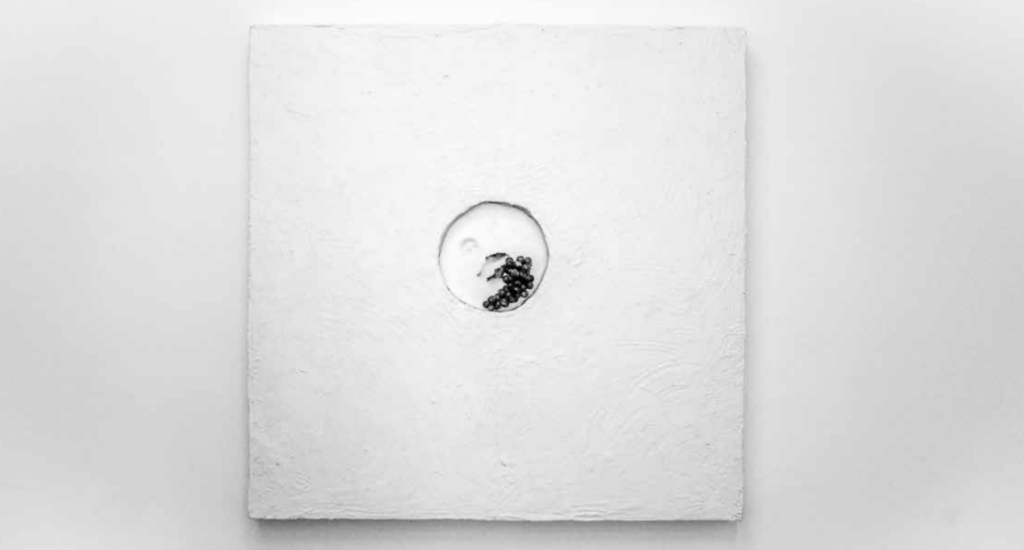Virginia Rose Torrence: Not What I Remember
Review II by Mary Lodu
The White Page
Oct 14–Nov 14, 2016

Not What I Remember is the still life reimagined. In place of traditional renderings, where sumptuous arrangements are imbued with allegorical and moralistic messages, Torrence experiments with the genre by composing sculptural forms that pointedly allude to the body. Portraits within this tradition typically signify the temporality of life by depicting material desires in ways that reminds us of their eventual decay. By borrowing and abstracting from this thematic structure and its visual grammar, these meditative works examine bodily absence, or as Torrence states, “the presence of absence” while raising questions of materiality. How are certain forms and textures utilized to communicate presence within a fixed state? In what ways does the work construct varied understandings surrounding the body?
Breaking away from a two-dimensional barrier, Torrence employs a mixture of plaster, foam, wax and paint to develop a series of works with various visual and tactile effects that place an emphasis on process. Plaster and wax hold particular significance as mediums in their wide use for replicating the human form. In Untitled (Portrait and Snake), both mediums are combined with a soft, rose colored pigment that recalls the range of hues found in floral depictions and the milky consistency extending from the paint’s surface allows the viewer to trace the artist’s individual marks. Just above the center, two pairs of hollowed eyes peer out as a fragmented serpent slithers below the base, as if capturing a moment where two human subjects have dematerialized, unable to return the viewer’s gaze.
When read against other titles, including Untitled (She) and Untitled (Apple) the biblical narrative of Adam and Eve is called to mind, yet not with the intention of instilling moralistic meaning alone. Artificial fruits blended with wax touch on the notion of “forbidden fruit,” from which an understanding of flesh and in essence, our physicality may be extracted. The apple is a metaphor for the flesh or more specifically, the temptation to satisfy bodily needs. Although the original sin is a narrative that has marked our perceptions of gender, informing how male and female bodies have been represented throughout visual culture, it remains unclear exactly what type of presence or subject Torrence is attempting to uncover here. Whether it be real or imagined, corporeal or spiritual—these visual elements faintly point to female subjectivity. The assortment of fruit and textures mimicking candle-wax or drapery offer a sense of domesticity and sensuality that one may encounter in painting scenes depicting the reclining nude or odalisque.
More rudimentary in conception, the organic, simplified compositions in Untitled (Bite) and Untitled (Snake Hole), are produced from plaster alone. Although each of the wall hung pieces demonstrate the ability of sculpture to break away from the constraints of canvas, there is a greater sense of materiality within Untitled (Bite) in how the work, though less detailed, maintains the capacity to convey as much meaning and emotion. The broad bite marks engraved onto its uneven surface bring forth a level of anguish that may not be felt in the same way had the work been constructed from another material. Its execution conveys the physical act of art-making and how the body is always present even in its absence.
The content of these sculptures seem largely defined by their materials, reflecting on traces of embodiment in inconclusive ways. Having prior knowledge of the history of still-life painting and the artist’s intent allowed me to connect with this work on a deeper level, but it was not essential to appreciating the work because Torrence experiments with form, color and texture in ways that are visually captivating. The artist was also successful at applying an existing framework from a genre that spans several centuries and has developed through style and technique into a contemporary context. Instead of placing emphasis on hyper-realism and moral purpose as the Dutch masters or fixating on color and mood like the Impressionists, the artist combines different formal aspects to create content that is deeply embedded in the creative process and its profound relation to the human body.
